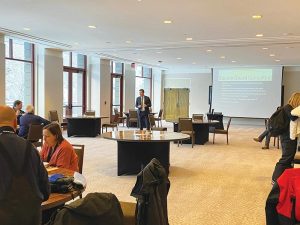By Kris Dekker and Peter Riggs, Spencer Fane LLP
1. What business trends were accelerated or exacerbated by Covid-19 in 2020?
As we look back on what was a truly historic year, it bears noting at the outset that the disruption and suffering that so many people experienced in 2020 can hardly be overstated. The loss of life, of human connection, of jobs, and of economic opportunities, was unlike anything we have seen in modern times. We should never lose sight of the human impact of this pandemic and, as we look forward to hopefully better days in 2021, we must remain mindful of the devastating impacts of Covid-19 on so many people’s lives.
From an exclusively economic perspective, the most significant story of 2020 was the degree to which federal stimulus was able to significantly mitigate the impact that the pandemic had on the economy. Once it became clear that Covid-19 was spreading rapidly in the United States and restrictions on person-to-person contact would be required, analysts predicted waves of commercial bankruptcies across numerous industries. Ultimately, however, while it was an active year for commercial bankruptcies, the volume of filings was substantially less than predicted, predominately because of government stimulus, in the form of PPP and other loans, stimulus payments, and expanded unemployment benefits that helped maintain consumer spending and prevent even greater job losses.
The impact of the pandemic across different sectors of the economy was by no means uniform. Certain sectors faced devastating impacts, while others thrived. Not surprisingly, many companies were able to adapt to the pandemic using new delivery models for their products and services, some of which may continue after the pandemic.
Physical Retail
Since the emergence of online retail, physical retail (retail operating in physical locations rather than online) has been in decline, and the pandemic has accelerated that decline. In 2020, the pandemic-related restrictions caused physical retail to experience a significant drop in foot traffic. Compounding the problem for physical retail is that the restrictions, in many cases, pushed consumers to find online alternatives, which could very well impact consumer behavior beyond the pandemic. Notable retailers that sought bankruptcy protection in 2020, include JC Penny Co. Inc., Neiman Marcus Group Inc., Lord & Taylor, Guitar Center, Tailored Brands (including retail brands Men’s Wearhouse and Jos. A. Bank), Ascena Retail (including retail brands Ann Taylor and Loft), GNC, J. Crew, Brooks Brothers, Stein Mart, Pier 1 Imports, Century 21 Department Stores LLC, True Religion, and Sur La Table.
The decline in physical retail has also impacted commercial real estate. Struggling retailers became unable to pay rent, which impacted income and property values for commercial property owners. Two major mall owners filed for bankruptcy protection this past year: CBL Properties and PREIT.
Other Businesses Dependent upon Physical Presence
Some otherwise strong businesses suddenly found themselves in crisis as a result of a sudden shift in consumer behavior, most notably those businesses that depend on the consumer’s physical presence. Several such companies sought bankruptcy protection in the fitness center space (Yoga Works, Cyc Holdings, owner of Cyc Fitness, Gold’s Gym International, 24 Hour Fitness Worldwide, Inc., among others), the restaurant industry (California Pizza Kitchen, FoodFirst Global Restaurants, owner of Brio, Garden Fresh Restaurants, owner of Souplantation and Sweet Tomatoes, and CEC Entertainment, parent company of Chuck E. Cheese, among others), and movie theater chains (Studio Movie Grill Holdings, Cinemex USA Real Estate).
The travel industry also suffered significantly from the restrictions and health concerns arising from the pandemic. While the airlines were beneficiaries of a $25 billion government bailout, other travel-related businesses such as hotels, rental cars, and ride hailing services were not as fortunate. Rental car company Hertz is the most prominent example that wound up in bankruptcy in 2020. Other downstream vendors such as VRBO and AirBNB owners also saw significantly reduced revenues on account of declines in travel overall, and customer weariness associated with booking non-standardized rental units during a pandemic.
Energy
The sharp decline in personal and business travel and daily office commutes, combined with price wars in global markets, has sent oil and gas prices to historic lows and accelerated a multi-year decline for oil and gas companies in 2020. According to a recent analysis by Haynes and Boone LLP, 45 oil and gas drillers filed for bankruptcy during the first 11 months of 2020 citing some $54 billion in debts. Similarly, in the oil field service industry, 57 companies filed for bankruptcy protection during the same period, citing $41B in debts.
Bright spots
Of course, not all segments of the economy suffered. The effects of Covid-19 have accelerated the prospects of online retailers such as Amazon, connectivity services such as Zoom, home improvement stores such as Lowes and Home Depot, home fitness equipment manufacturers such as Peloton, entertainment services such as Netflix and video game platforms, and big box retail such as Walmart and Target. These businesses boomed in large measure due to changes in consumer behavior resulting from pandemic-related restrictions and concerns.
The travel industry also suffered significantly from the restrictions and health concerns arising from the pandemic. While the airlines were beneficiaries of a $25 billion government bailout, other travel-related businesses such as hotels, rental cars, and ride hailing services were not as fortunate.
2. What are some top concerns for business owners and employers in the realm of bankruptcy and restructuring?
While 2020 was an active year for commercial bankruptcies, the volume of filings was not as substantial as predicted in the spring. As mentioned above, this is in large part because of government stimulus. Additional recently-enacted stimulus and the rollout of vaccinations give reason for optimism in 2021, but significant uncertainty remains, and we anticipate still a further decline in the economy before any improvement.
Office real estate may become an increased area of concern in 2021. A shift to remote work in many industries may cause many businesses to re-evaluate their office space needs. That could lead to reduced demand and ultimately reduced rent and property value for owners of office real estate.
With respect to commercial loans, many lenders adopted a “wait and see” approach during 2020, with most being willing to grant deferral and forbearance agreements to their borrowers. The patience of lenders may wane, however, as non-performing loans create a drag on portfolio performance. In view of that, we anticipate a moderate uptick in loan enforcement in 2021.
For business owners who are considering reorganization as a means to maintain their business operations but who have granted personal guaranties with respect to their business’s debts, those owners will want to first confirm whether the business’s bankruptcy triggers additional liability under their personal guaranties before they undertake any action for reorganization.
3. What changes may be coming up (or what recent changes have taken place) due to regulations or public perceptions?
Most people believe, based on guidance from medical professionals and government officials, vaccination efforts should allow COVID-related restrictions to be eased sometime in 2021, hopefully putting many businesses that have been impacted by those restrictions back on the path to recovery. While uncertainty remains about how quickly the restrictions can be eased and how soon thereafter the economy will recover, we have at least some clarity about what to expect with regard to that timeline. This greater clarity should help businesses plan and provide banks greater comfort in extending bridge financing, maturity extensions, and forbearances to their customers, enabling those customers to get through the remainder of the pandemic. Greater certainty should arrive as the vaccination efforts continue over the coming months and the public health picture comes into clearer focus.
Despite our anticipation that pandemic restrictions are likely to ease during 2021, some economists still believe there may be a surge in commercial bankruptcies at some point this year as government stimulus tapers off. While additional government stimulus is still planned, some think it may be ultimately insufficient to keep many businesses from filing for bankruptcy, raising a concern about whether there will be sufficient judicial bankruptcy resources and debtor-in-possession financing for small businesses.(1) In the event a bankruptcy surge of significant magnitude begins to emerge, the government may address these concerns, but additional legislative reform is unlikely at the present time.
4. Is the need for bankruptcy relief being exacerbated by COVID-19?
While the pandemic has certainly put an economic strain on many businesses, most notably those relying on the physical presence of customers, such as hospitality, restaurants, retail, and theaters, the unprecedented economic stimulus injected by the government in 2020 appears not only to have staved off any increase in commercial bankruptcies, but perhaps actually decreased them, at least for the time being, relative to historical levels. Through November of last year, 30,310 commercial bankruptcies were filed in the U.S. Assuming a uniform monthly pace of filings, that would result in approximately 33,065 filings for 2020. By comparison, in 2017, 2018 and 2019, there were 39,050, 38,044 and 38,536 commercial bankruptcies filed, respectively. (2) 2020 did see an increase in Chapter 11 filings, with the largest amount of commercial cases filed (6,735 through November 2020) since 2012 (7,289 Chapter 11 cases).(3)
Looking forward, both parties of government seem intent on extending additional stimulus as we move through 2021 in a continued effort to save businesses and jobs, and the vaccination efforts provide real reason to believe that COVID-related restrictions could be eased at some point this year. In view of those developments, there is optimism that COVID will not ultimately force significantly greater numbers of companies into bankruptcy than would have otherwise have filed without the impacts of COVID.
That said, undoubtedly, there are many companies that have merely survived the pandemic thus far and have depleted cash reserves and other capital to do so. Once that capital is spent and government stimulus tapers off, these companies may need to consider bankruptcy.
There also are businesses who may not absorb the full impact of the pandemic for several years yet. For instance, if companies ultimately find work-from-home arrangements to be economical, effective and popular on a long-term basis to a degree that allows them to reduce their office footprints, the office landlords may not feel the impact of that reduced demand until the leases begin to expire. And some businesses may never return to their pre-COVID revenues, because their customers’ preferences may have changed during the pandemic, such as consumers who acquired a new-found preference for online, delivery and curbside services, all of which could lead to additional bankruptcies long after the COVID virus has been contained.
5. How might businesses position themselves for the best outcomes? Are there alternatives?
Be proactive. Every business should evaluate what it needs to sustain its operations through the end of the COVID-related restrictions. In connection with that, businesses will want to consider whether their industry is likely to recovery quickly or more slowly once those restrictions are eased. Once the capital needs of a business are reasonably determined (understanding, of course, that uncertainty still exists regarding just how long it will be until those restrictions are eased and the economy returns to pre-COVID strength), it should identify its sources of potential capital. For many small businesses, this will primarily be its lender. Businesses should engage in conversations with their lenders as early as possible. Most banks, thus far, with encouragement from government stimulus and a desire to maintain their relationships with their customers, have liberally granted their borrowers some form of payment deferral when requested. When justified, banks have also agreed to restructure long-term debt, understanding that the pandemic, while still causing immediate economic strain, will eventually come to an end.
Look to your bank for advice. Some banks have become not only a source of credit to its customers but also a growing resource of business information, even offering classes and workshops covering topics such as finance, management and leadership, sales and marketing, human resources, and information technologies. Most banks will be able to provide their business customers with the latest information regarding COVID-specific lending programs, such as the Paycheck Protection Program and Economic Injury Disaster Loans that were previously-enacted by Congress. Because the government appears committed to extending additional COVID-specific stimulus programs throughout 2021, forming a good relationship with your lender will position you well to take advantage of these programs as they become available.
Business who are suffering from COVID-related restrictions may also want to consider whether they can adapt their operations to help mitigate the impacts of COVID. Many businesses in the restaurant, retail and grocery industries have been successful in quickly implementing new delivery and curbside services. In some cases, these new services have been so successful, that business owners will likely want to consider continuing these services after the pandemic is over.
Unfortunately, business that have been significantly impacted by the pandemic may need to consider bankruptcy. In some circumstances, this may mean winding down operations and liquidating, but in other circumstances, this could mean reorganization, which entails obtaining some form of debt relief, but results in the business operation continuing rather than winding down. With regard to reorganizations, in 2019, Congress enacted the Small Business Reorganization Act of 2019, creating a faster and more efficient reorganization option for small business debtors. Originally, this option was available only to businesses with debt not exceeding $2,725,625, but in reaction to the economic fallout from the COVID pandemic, Congress expanded this option, making it temporarily available through March 27, 2021 to businesses with debts up to $7,500,000. For small businesses in need of debt relief, reorganization under the Small Business Reorganization Act is a far more viable option from a cost and efficiency standpoint than the standard Chapter 11 bankruptcy, which was previously the only option available for reorganization. The goal of this new reorganization option is to allow more small businesses an opportunity to remain in operation.

Kris Dekker is a partner at Spencer Fane LLP in the firm’s Kansas City office. He helps banks, financial institutions and other lenders of varying sizes close their transactions efficiently, representing them in all phases of lending.

Peter Riggs is a partner at Spencer Fane LLP in the firm’s Kansas City office. He is an experienced litigator and regulatory attorney that advises clients across the financial services industry in litigation, government and internal investigations, and bankruptcy and creditors’ rights matters.








